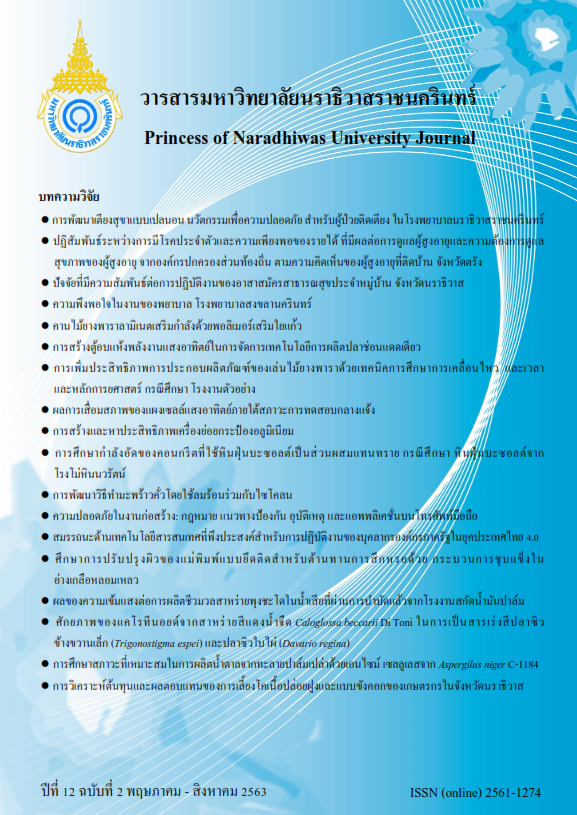การพัฒนาเตียงสุขาแบบเปลนอน นวัตกรรมเพื่อความปลอดภัย สำหรับผู้ป่วยติดเตียงในโรงพยาบาลนราธิวาสราชนครินทร์
คำสำคัญ:
เตียงสุขา, นวัตกรรมความปลอดภัย, ผู้ป่วยติดเตียงบทคัดย่อ
การวิจัยนี้ มีวัตถุประสงค์เพื่อพัฒนาและศึกษาผลการใช้นวัตกรรมเตียงสุขาแบบเปลนอนในการลดอุบัติการณ์ความเสี่ยงจากการขับถ่าย และศึกษาความพึงพอใจของพยาบาลและผู้ดูแลต่อการใช้นวัตกรรมเตียงสุขาแบบเปลนอน คัดเลือกกลุ่มตัวอย่างโดยการสุ่มอย่างง่าย คือ พยาบาลวิชาชีพ จำนวน 30 ราย และผู้ดูแล จำนวน 30 ราย เครื่องมือในการเก็บรวบรวมข้อมูล ได้แก่ แบบบันทึกภาวะแทรกซ้อนของโรค แบบบันทึกอุบัติการณ์ความเสี่ยง และแบบสอบถามความพึงพอใจ วิเคราะห์ข้อมูลโดยใช้สถิติพรรณนา
ผลการศึกษา พบว่า ผู้ป่ วยที่ใช้เตียงสุ ขาแบบเปลนอน ไม่เกิดภาวะแทรกซ้อน ไม่มีการเปลี่ยนแปลงของสัญญาณชีพ ไม่เกิดการพลดั ตกหกลม้ และไม่เกิดการอบั ช้ืนของผิวหนงั คิดเป็ นร้อยละ100 พยาบาลวิชาชีพ มีความพึงพอใจอยู่ในระดับ มากที่สุด 3 ด้าน ได้แก่ ด้านความประหยัดการประยุกต์และความปลอดภัย มีค่าเฉลี่ยเท่ากับ 4.61 (SD = .48), 4.58 (SD = .53) และ 4.57 (SD = .48) ตามล าดับและความพึงพอใจด้านความมีประโยชน์อยู่ในระดับมาก มีค่าเฉลี่ยเท่ากับ 3.90 (SD = .44) ในขณะที่ผู้ดูแลผู้ป่ วยมีความพึงพอใจต่อการใช้นวัต กรรมเตียงสุขา อยู่ในระดับมากทุกด้าน ได้แก่ ความปลอดภัย ก าร ป ร ะ ยุ ก ต์ ใ ช้ ค ว าม ป ร ะ ห ยัด ค ว า ม มี ป ร ะ โ ย ช น์ โ ด ย มี ค่ าเฉ ลี่ ย 3.00 (SD = .00), 3.00 (SD = .00), 2.97 (SD = .13) และ 2.45 (SD = .30) ตามลำดับ เตียงสุขาแบบเปลนอนสามารถลดความเสี่ยง และเพิ่มความปลอดภัย ให้ผู้ป่วย พยาบาลที่ให้การดูแลผู้ป่วยติดเตียงจึงควรนำมาใช้เพื่อดูแลผู้ป่วยขณะขับถ่ายโดยเฉพาะผู้ป่วยมุสลิมที่ต้อ งทำความสะอาดด้ว ยน้ำหลัง ขับถ่ายสอดคล้องกับ มิติด้านจิตวิญญาณ
เอกสารอ้างอิง
Butimal, P., Isaramalai, S., & Thaniwattananon, P. (2018).Development of Nursing Practice Guideline for Preventing Complications in Bed-Bound Elders at Home. Songklanagarind Journal of Nursing, 38(3), 79-91.
Chantra, C. (2016). Problems and Requirements of Primary Caregivers in Involving Nutrition and Bed sore Prevention of Bedridden Elderlies. Princess of Naradhiwas University Journal, 8(3), 41-50.
Hayeese, W et al. (2018). Innovation Electrically Heated Blankets of Temperature in the Premature Infants. Princess of Naradhiwas University Journal,10(2), 1-12.
Kuiburd, T., Suksabay, P., Duerah, A., & Wansawat, T. (2018). Innovative Toilet Bed Safety for patients restriction in Naradhiwas Rajanagarindra Hospital. (In Thai).
Lertthaitrakul, W. (2011). The Deming Cycle (PDCA). Retrieved from http://business.east.spu.ac.th /admin/ waaa_file/ A37322PDCA.pdf.
Medical record male internal medicine. (2018). Incident medical record Naradhiwas rajanagarindra Hospital. (In Thai).
Medical Statistics record. (2018). Thai Muslim patients record Naradhiwas rajanagarindra Hospital. (In Thai).
National Health Security Office. (2017). Report of national health insurance fiscal year 2017. Nonthaburi. National Health Security Office Ministry of Public Health.
Nima, Y. & Hasuwannakit, S. (2008). Medical and patient care For health service based on Islamic ways. Songkhla: Southhsri. Prince of Songkhla University. (In Thai).
Phatklay, P., & Kueasakul, C. (2017). Happy Hair Mobile for Hair Shampooing of Patient in Phangnga Hospital, Journal of Health Science, 26(5), 875-882.
The Healthcare Accreditation Institute (Public Organization), (2018). Patient Safety Goals Simple Thailand 2018. Nontaburee: famous and successful. (in Thai).
Wangthong, A., Wangthong, A., Watsen, T., & Suttarangsri, W. (2013). Clients' perspectives on humanized nursing care within a multicultural context: a case study of Nongjik district, Pattani province, 23(3), 35-44.




